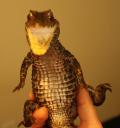» Site Navigation

0 members and 586 guests
No Members online
Most users ever online was 47,180, 07-16-2025 at 05:30 PM.
» Today's Birthdays

» Stats

Members: 75,912
Threads: 249,117
Posts: 2,572,191
Top Poster: JLC (31,651)
Welcome to our newest member, coda
|
-
Registered User

50% het?
Can somebody please explain what "50% het" means? Is it correct to say a animal is other than just plain het?
-
-
It means there is a 50% chance the animal is het for a gene, as there's no way to tell what animal carries it unless it's visual or it's 100% het.
Last edited by Skittles1101; 03-10-2012 at 08:28 AM.
2.0 Offspring, 1.1 Normal Ball Python, 1.0 Pastel Ball Python, 0.1 Albino Ball Python, 0.1 Pinstripe Ball Python, 0.1 Banana Ball Python, 1.0 Pied Ball Python, 1.0 Normal Hognose, 0.1 Veiled Chameleon, 0.0.1 G.pulchra, 0.1 P.metallica, 0.1 M.giganteus
-
-
Registered User

Re: 50% het?
 Originally Posted by LGray23

It means there is a 50% chance the animal is het for a gene, as there's no way to tell what animal carries it unless it's visual or it's 100% het.
Thanks. What other percentages are often used to describe the chance of the animal being het and in what cases would we use them?
-
-
BPnet Veteran


66% chance from het to Het breeding 50% chance from het to normal 100% het from homozygous to anything.
-
The Following 2 Users Say Thank You to jason79 For This Useful Post:
adamsky27 (03-11-2012),Skittles1101 (03-10-2012)
-
Registered User

Re: 50% het?
 Originally Posted by jason79

66% chance from het to Het breeding 50% chance from het to normal 100% het from homozygous to anything.
Can you please explain how you arrive at these probabilities? i'm a little confused. Thanks
-
-
BPnet Veteran


Het to normal half the babies statistically should be hets. Het to het 2 out of 3 should be hets. So thats where the 50% and 66% come from. all the hets look normal so there is no way to tell which are and which aren't so they call them 50% or 66% hets meaning that there is statistically a certain percent chance they will be hets, but there is also a chance they are not.
Last edited by jason79; 03-10-2012 at 09:01 AM.
-
-
Het x het breeding
Genetic Wizard 3.0 calculations by

In this you can't tell between the hets and the normals, therefore they are 66% het instead of selling a normal as a het, since there is an equal chance of being het.
Het x normal
Genetic Wizard 3.0 calculations by

In this breeding, only 50% because it's literally split in half.
Homo x normal
Genetic Wizard 3.0 calculations by

All are het, therfore they are 100% het even though they all look normal.
2.0 Offspring, 1.1 Normal Ball Python, 1.0 Pastel Ball Python, 0.1 Albino Ball Python, 0.1 Pinstripe Ball Python, 0.1 Banana Ball Python, 1.0 Pied Ball Python, 1.0 Normal Hognose, 0.1 Veiled Chameleon, 0.0.1 G.pulchra, 0.1 P.metallica, 0.1 M.giganteus
-
The Following 2 Users Say Thank You to Skittles1101 For This Useful Post:
joebad976 (03-10-2012),PitOnTheProwl (03-10-2012)
-
An offspring is either het or he he is not in other way he carries the gene for the recesive morth or he does not.
When a homozygous animal is paired to a normal there is obviously no question that all the offsprings will carrry the recessive gene and therefore they are reffered to as het or 100% het, now the tricky part is when a het is paired to a normal or a het.
In both cases if you pair a het to a het or a het to a normal not all the normal looking offsprings will carry the gene for the recessive Morph, some will and some won't, however since it is impossible to distinguish which ones do and which one don't, all the normal looking offsprings are referred to as possible het either 66% or 50% depending on the original pairing.
This mean if you purchase a possible het from a het x het it has 66% chances to be a het and the only way to find out whether the animal you bought is a het or whether it is a normal will be by breeding the animal and proving or disproving him.
Same goes for 50% het.
-
The Following 2 Users Say Thank You to Stewart_Reptiles For This Useful Post:
joebad976 (03-10-2012),Slim (03-10-2012)
-
I agree with the above statements, and I see it like so:
Seems that people are dropping the percentage a lot nowadays and just list listing the animal as PH (possible het). I think that the percentage chance is good to know if you are choosing between two animals and all other things are equal.
The odds are per animal, not per clutch really, so the clutch could be all hets or zero hets. Each animal has the percentage chance of carrying the gene. I think some confusion arrises because we drop a word and say 66% het versus the full 66% possible het.
Really, the animal itself is het or not het, but knowing the odds can help in decision making during purchase as hets do not have 100% reliable markers for the gene.
-
The Following User Says Thank You to Royal Hijinx For This Useful Post:
Skittles1101 (03-10-2012)
-
I don't breed and I'm not a genetics guy, but can I assume that clutches with multiple possible sires complicate the Het math?
Thomas "Slim" Whitman
Never Met A Ball Python I Didn't Like 
-
 Posting Permissions
Posting Permissions
- You may not post new threads
- You may not post replies
- You may not post attachments
- You may not edit your posts
-
Forum Rules
|